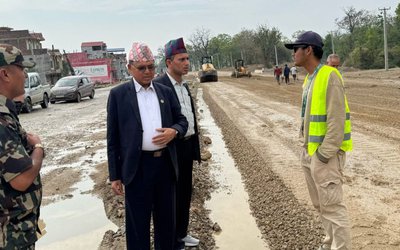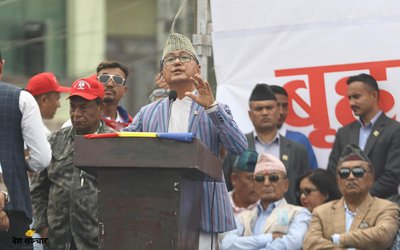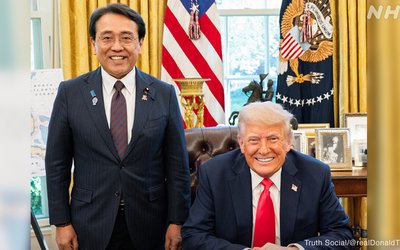
For years, Nepal-China trading point Rashuwagadhi has remained a small custom office for trading. Following the closure of Tatopani border point due to the devastation by earthquakes, Rasuwgadhi has turned into a major border hub. Chief of RasuwagadhiCustoms office KEDAR PRSAD PANERU spoke to NEW SPOTLIGHT on various issues. Excerpts:
As this is the only trading point now operating for trade with China, what are the challenges you are facing?
First of all, every custom point needs a basic infrastructure to make effective clearances. This is what is lacking here. Infrastructure is a must for custom and trade facilitation as the road has connected Rasuwagadhi to Chinese town Kerung.
How do you look at the volume of export and import from the Rasuwagadhi customs now?
The volume of goods imported from People's Republic of China has increased by many folds. We have been receiving almost 30 to 40 loaded trucks of goods from the Chinese side. However, there is the lack of custom yards to park the trucks coming from China. With my own initiative, I have cleared a river land and made a temporary yard at the bank of river. Of course, there is a lot of congestion; we are managing the custom clearance somehow.
How many containers are you clearing now?
Currently, we are clearing up to 30 containers. As volume of products stored in Kerung China is going up, Chinese custom officials are requesting us to allow at least 75 to 100 containers a day so that the clearance there will see more space for new goods.
What are the other problems you are facing?
Along with lack of yards, there is also the scarcity of officials. This used to be a small custom office till Kodari was open. After the recent earthquake destroyed the infrastructure and roads in Kodari, this has become the only one entry point now. So there is a huge pressure on us. Ministry and Department have assured me they would provide additional staff here. After the destruction of our custom office and official residence by the April 25 earthquake, we are now working from a rented house with space congestions. As the earthquakes are still shaking, it may take a few more years for us to see a new building for our office.
How have you taken up these challenges?
There are many challenges. One of the major constraint is in the infrastructure. For the trade facilitation and customs, we should have well equipped office with infrastructure in place. However, this is lacking here. This is a place linked only by road transport. Custom yards and go-downs are very important for storage. With the support from Chinese government, the study on the construction of dry port is already going on.
How do you find the facilities across the border in the Chinese town Kerung?
They are also constructing the warehouses and infrastructures needed to store the goods in Kerung. They are also planning to bring railway by 2020 in Kerung. They are developing Kerung as a special economic zone. They are developing a well managed city. In Nepalese side of the border, Interstate Multi-Model has already started to construct a dry port in Timure of Rasuwa. Nepal and China have signed the agreement. The government has already issued notice for land acquisition.
Who are the importers?
An important thing is that we are importing more products than exporting. This is a border point where importers are small enterprises. They import small amounts of products targeting at the middle class and low class population of Nepal. Unlike other border points of the south, there are goods of several businessmen in one container. With the orders of Nepalese businessmen, Chinese transporters are carrying goods up to Kerung. Nepalese importers know about their goods only after they arrive at our customs yard. This is the custom point where an overwhelming variety of the goods are imported by small entrepreneurs. It will take some time to manage it. Before fixing the customs tariff, we upload all the goods and later upload it again after the payment of customs tariff. It is a very tedious process. However, we have to do it. We make the packing list and declare the custom tariff.
What is the state of the custom office?
We don’t have our own building and we live in a rented house. There was no telephone when I arrived and now there is a computer service provided under VSAT. Nepal Telecom is also installing systems.
How long does it take to clear goods here?
We are now clearing the goods in three hours. We can use green channel for the goods like apple, garlic and onion imported from China. However, this is not possible for other products. We need to look at the entire package. I have just 19 staffs, including 16 inspectors.
What are the other problems?
As the survey for construction of Integrated Customs Office at Timure dry port is already started, there will be a lot of problems until the completion of the building work. As there is no adequate space for newcomers so I cannot even include new staff even as there is an increasing import volume. At one time, the customs generated no money at all. However, we are generating over 30 million rupees in a day these days. We are working very hard. Difficulty is in making the packing list. Volume of import is increasing.
How do you see the future of Rasuwagadhi?
As the government has already announced to construct two-lane roads from Syaphrubeshi linking Trishuli by two years, this point is going to be a major trade point between Nepal and China in the future. After completion of the project, the road will be shortened and it will be easy.
What is the state of road?
As you know, the road linking Rasuwagadhi is a single lane. The road has many bends from Syaphrubeshi to Trishuli. Travel thus is very time consuming. There are two very fragile and vulnerable areas in Ramche where almost 5 kilometers of road is under a perennial threat of landslides. We need to make it all weather. This trade route has a huge potential to export and import goods in the future. There is the need to provide regular maintenance for the roads.
How do you see the possibility of increasing future revenue generation?
I can claim that we have been generating a huge amount of revenue compared to last year. The custom collected just 80 million rupees in revenue last fiscal year. This year, we are given 390 million target. However, we have already collected 160 million by the end of November. If the pace of imports continues, we will fulfill the current target given by the department by end of December. My own target is to collect 2 billion rupees given the present pace and state of road.
How do you coordinate with all the officials?
Rasuwagadhi Customs Office is just a small office. I have requested the department to preserve the historical site of Rasuwagadhi, and road networking to make it two lane. Nepali truck container drivers are yet to get a one-day permission. This is creating huge problems in carrying the goods from Kerung. I have already requested this to Ministry of Foreign Affairs and Immigration Department. One day pass will not be issued on the model of Tatopani because it invites so many bad practices. There are efforts to issue the one day passes very shortly. Nepali container drivers and importers should be given one day passes to bring their goods to Nepal.
How many drivers are driving the vehicles?
Presently, there are 30 drivers from Rasuwa monopolizing the license. They are demanding a huge money to drive goods from Chinese port of Kerung to Nepal. There is a provision that people living in 36 kilometer areas are given temporary passes to go to Tibet. There are additional prices the Nepalese importers are paying.
- NEPAL-THAILAND: Joint Business Council
- Apr 13, 2025
- BIMSTEC SUMMIT: Nepal’s Stand
- Apr 11, 2025
- IME GROUP: Expands Into Paper Industry
- Mar 24, 2025
- CPN UML: Instigated By India
- Mar 23, 2025
- ADB’S CHIEF ECONOMIST: Nepal Reduces Poverty
- Mar 11, 2025















